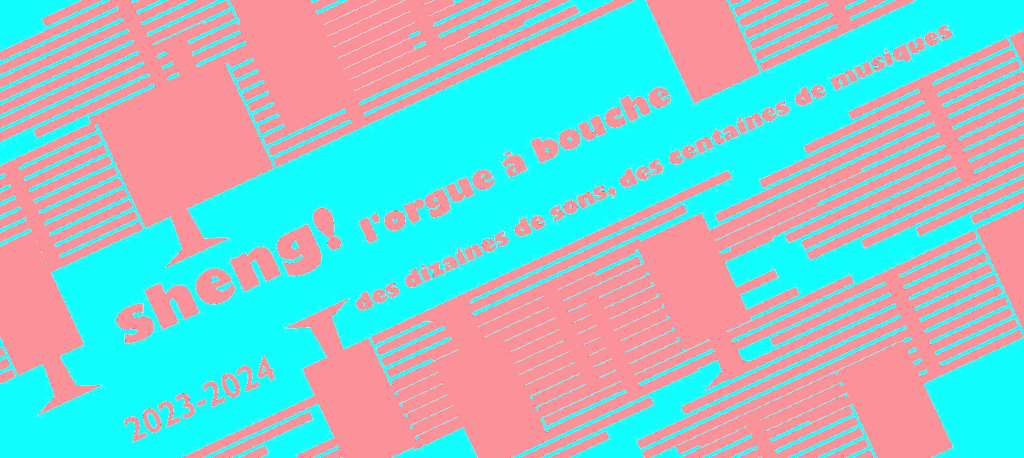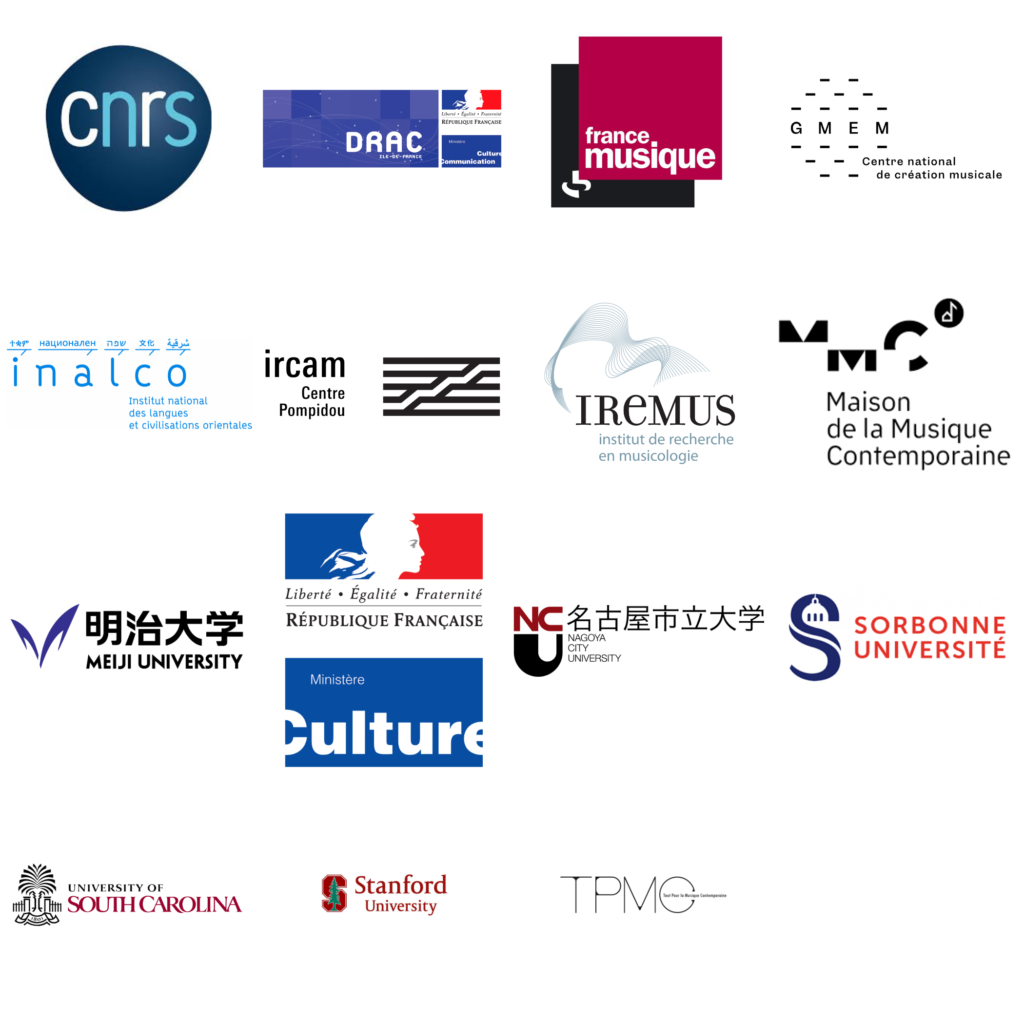
Jean-Marc Chouvel (Sorbonne Université, IReMus)
Pierre Couprie (Université d’Évry / Université Paris-Saclay)
Liao Lin-Ni (TPMC – IReMus)
Mikhail Malt (IRCAM – IReMus)
François Picard (Sorbonne Université, IReMus)
Liao Lin-Ni, Direction of Research “sheng! l’orgue à bouche”
The Forest of Bamboos – Ornithology project concerns acoustic, organological, musical and cultural analyses on the sheng! Mouth Organ (2019-2026), a traditional Chinese instrument, and additionally supports contemporary repertoire and new commissions for the sheng.
In Ornithology, we are once again inviting the Chinese-American composer – Julie Zhu (carillonnist, mathematician, visual artist) for a second commission following her work Forêt de Bambous – Somme et Différence, commissioned, recorded, and broadcast by Radio France and CNCM-GMEM in 2023.
This new 2024 work pairs the sheng with an instrument the composer designed herself: a wooden box outfitted with contact mics that she draws on, the sound of which is processed through Max/MSP. Her live drawing gestures duet with and alter the sheng’s sound, which is amplified by a custom microphone system – a hybrid instrument designed by Alexis Baskind (electronics and live sound) and Wu Wei (sheng master).
In this seminar, we will focus on the musical, aesthetic and technological evolution of this second work by Julie Zhu for the Forest of Bamboos system. The project is intricately linked with previous research on the amplification and sound of the sheng created by the Forest of Bamboos team, and for this seminar, all four members will be physically present, as the seminar will be directly the day after the premiere of Ornithology.
——
Coproduction: CNCM-GMEM and Tout Pour la Musique Contemporaine (TPMC)
The project is supported by: DRAC Provence-Alpes-Côte d’Azur, CNCM-GMEM, Ircam, Maison de la Musique Contemporaine and University of Michigan
——
Mikako Mizuno: The expansive theatrical space of Mayumi Miyata
In the mid-1980s, contemporary Japanese composers and audiences discovered a young shō player named Mayumi Miyata. After graduating from the piano course of Kunitachi College of Music in 1975, she devoted herself to music aesthetics and began studying gagaku under Tadamaro Ono, Hiroshi Togi, and Sukeyasu Shiba. In 1983, Miyata gave the first solo recital for shō. Several composers immediately began creating new pieces for shō , heralding a new phase of identity for the traditional instrument. Miyata collaborated with Japanese composers, such as Shigeaki Saegusa, Toshi Ichiyanagi, Maki Ishi as well as Jean-Claude Eloy and Cort Lippe before working with Toshio Hosokawa.
This presentation shows how Miyata opens theatrical space through expansive sound, looking at her fruitful collaboration with composers in the 1980s and her recent projects with young musicians and orchestral work.
Mikako Mizuno: Enlarged tradition in contemporary repertoire of Japanese shō succeeding and creating of sound space
Mikako Mizuno: Japanese shō and the master of contemporary repertories, Naoyuki Manabe
Mikako Mizuno: Shō, Gagaku and modern harmony in Yoritsune Matsudaira (1907-2001) – interpolarity between harmony and timbre
Mayumi Miyata (b.1954) has played a key role in the development of the shō’s contemporary repertoire. Among the many composers with whom Miyata has collaborated, Toshio Hosokawa (b.1955) occupies a particularly important place due to his prolific work for the instrument. Since 1985, he has composed sixteen works for shō, alone or with other instruments, always entrusting the shō to Miyata.
In this presentation, we will look at the collaborative work between these two musicians, studying various aspects, such as historical context, Miyata’s contribution to Hosokawa’s musical development, and the characteristics of his writing for shō. Interviews with both Miyata and Hosokawa played an important part in the research for this presentation.
* Two other seminars focused on the works of Toshio Hosokawa for shō by Wataru Miyakawa –
Wataru Miyakawa: L’orgue à bouche shō dans l’œuvre musicale de Toshio Hosokawa
Wataru Miyakawa: Les langages musicaux inspirés du shō chez Tōru Takemitsu et Toshio Hosokawa
——————————
Biography – Mikako Mizuno
Composermusicologist. Mizuno’s music has been performed in many locations, including France (Bourges, Paris, Reims), Germany (Berlin, Köln), Austria (Salzburg, Linz, Vienna), Hungary (Budapest), Italy (Venice, Alba, Treviso, Udine) , Republic of Moldova, and in international festivals and conferences like ISEA, ISCM, EMS, Musicacoustica, ACMP, WOCMAT, NIME, and ICMC. More than twenty pieces of her computer music were premiered in JSEM concerts. Her compositions have been performed by the Tokyo Symphony Orchestra, Central Aichi Symphony Orchestra, Hiroaki Ooi, Satoko Tange, Naoyuki Manabe, Kazuya Ota. In 2016, she was an invited researcher at the Université Sorbonne Paris, working with the source materials inherited from Pierre Schaeffer.
Mizuno is currently a professor of Nagoya City University, the president of Japanese Society of Electronic Music(JSEM), and the Asia/Oceania Regional Director of ICMA.
Biography – Wataru Miyakawa
Wataru Miyakawa was awarded a scholarship from the French government and the Nadia and Lili Boulanger International Centre. He studied composition at the Conservatoire national supérieur musique et danse de Lyon and composition and computer music at the Institut de recherche et coordination acoustique/musique (IRCAM). He is the author of a doctoral thesis on the work of Tōru Takemitsu (published by L’Harmattan) and musicological articles on composers such as Kaija Saariaho, Toshio Hosokawa and Philippe Leroux. He was the scientific editor of Tōru Takemitsu’s Écrits (2018) (published by Symétrie), which he translated from Japanese with Véronique Brindeau. He is currently associate professor at Meiji University in Tokyo.
Composer Prof. Shen Ye talks about transformation in music composition. Transformation is a common technique in today’s music composition. Shen Ye discusses the importance of transformation in the conceptualization and organization of a work, using the piece DUO·鐸 (2015) pour sheng et daegeum as an example. Shen Ye will also talk about the cultural perceptions behind the transformational approach, using the works of different composers as examples. In addition, Shen Ye will also talk about how contemporary composers use electronic music analysis techniques as a probe to explore and train a personal link between sensory experience and the external world.
——————————
Shen has received commissions from Klangspuren, Heidelberger Frühling, and many international music festivals & associations. Ensemble Intercontemporain, Ensemble Recherche, Ensemble Les Amis, Ensemble TIMF, AsianArt Ensemble, Ensemble XXI. Jahrhundert Wien, Tokyo Philharmonic Orchestra, Shanghai Symphony Orchestra, Taipei Chamber Singers and world-renowned soloists such as Wu Wei, Yoo Hong, Zhi-Jong Wang, Lini Gong, etc. bring his works around the world.
22 Seminars – 43 Presentations List (Version October 2024)
Info l www. tpmc-paris.com
Reservation l reservation@tpmc-paris.com
Question – Contact l contact@tpmc-paris.com
research 2019-2020 ∣ research 2020-2021 ∣ research 2021-2022 ∣ research 2022-2023 ∣ research 2023-2024 ∣ research 2024-2025

